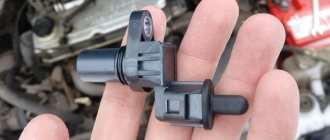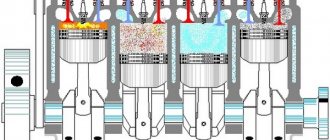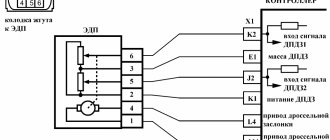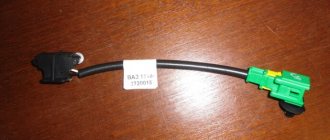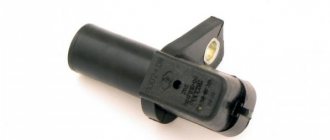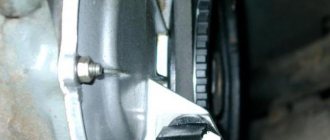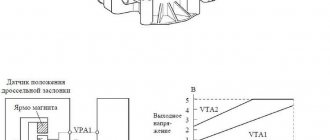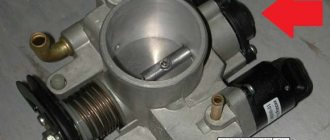In order to fix the angular position of the shaft, a Niva 21214 camshaft sensor is used. You can also hear another name for the device - phase sensor, or the abbreviation DPRV. It transmits the received information to the vehicle's electronic control unit. Thanks to the information received, the electronic control unit correctly distributes the fuel supply and adjusts the ignition in each cylinder at certain times.
The camshaft itself uses a rapper, which looks like a tooth made of metal. When the shaft begins to rotate, it is responsible for changes in magnetic fields using a position sensor in the camshaft. The sensor records information about changes in magnetic fields and converts it into an electrical signal. The electrical signal is transmitted to the vehicle's electronic control unit. DPRV records information only at the top dead center of one cylinder. On diesel engines, information about all cylinders is recorded, since a separate rapper is installed on each cylinder.
If the camshaft sensor on a Niva becomes inoperative, the electronic control unit may receive incorrect data or may not receive status data. Because of this, the car may accelerate poorly, drive poorly when going uphill or when loaded. Also, due to incorrect readings, fuel consumption can significantly increase several times, which will be immediately noticeable.
What is a camshaft sensor
Before moving on to the question of checking the camshaft position sensor, you need to find out what kind of device it is, what it is needed for and on what principle it works. This will help clarify the details of the audit in the future.
A camshaft sensor is a device that records the angular position of a specified shaft at a specific point in time. The information obtained with its help is transmitted to the electronic engine control unit (ECU), and on its basis this control element issues commands for fuel injection and ignition of the air-fuel mixture in each cylinder at a specific point in time.
The operation of the camshaft position sensor is based on the Hall effect. So, directly on the camshaft there is a metal tooth, which, when the shaft rotates, changes the magnetic field in a nearby sensor. This tooth is called rapper. The sensor detects a change in the magnetic field, which is converted into a low voltage electrical signal. This signal is sent to the electronic control unit.
In fact, the camshaft position sensor only registers one position, corresponding to the position of the piston of the first cylinder at top dead center. Next, phased fuel injection is performed in the firing sequence of the cylinders. Typically this is a 1-3-4-2 system.
If the camshaft sensor fails (the electronic control unit receives incorrect information from it or does not receive it at all), then it is programmed to switch to emergency mode. It involves the use of pairwise-parallel (group) fuel supply to the engine. This leads to two negative consequences:
- A slight loss of engine power, especially when driving in critical modes (acceleration, driving under load).
- Increase in fuel consumption by approximately 10...20% (depending on engine power, its design features, as well as operating conditions).
As for diesel engines, camshaft position sensors are designed similarly, but there is one difference. It lies in the fact that the sensor records the position of not only the first cylinder, but all of them. This is done due to the fact that the drive disk has a separate tooth for each cylinder.
Thus, if a sensor fails, it makes sense to diagnose it as quickly as possible and, if necessary, replace it.
Speeds
The Chevrolet Niva speed sensor helps to determine exactly how fast the car is moving. The received information is transmitted to the speedometer. In addition to this, it also performs such functions as:
- Controls fuel consumption
- Displays information on the dashboard
- In cars with automatic transmission, it is part of the system that is responsible for engine control.
If for some reason it fails, then further movement becomes difficult. The causes of failure may be contamination or oxidation. If the device stops working, first of all you need to check for the following problems:
- Contacts have oxidized
- There was a break in the electrical wiring
- Wire insulation is damaged
- There are mechanical damages
Diagnostics can be done both visually and using a multimeter. To do this, the sensor is removed, after which you need to connect the plus to the contacts, and the minus to the ground of the car. We switch the multimeter to power measurement mode and if it shows that the voltage has increased, then the element can be considered faulty.
Signs of DPRV failure
There are several typical signs that indicate that the camshaft position sensor has failed. It is immediately necessary to clarify that the symptoms listed below may indicate completely different malfunctions. Therefore, it makes sense to perform additional diagnostics. So, signs of a DPRV breakdown:
- Problems with starting the engine, under any conditions - “cold”, “hot” and in other modes. This usually results in having to crank the starter longer.
- Unstable engine operation, “floating” operating and idle engine speeds.
- “Dips” in the movement of the car; when you press the accelerator pedal, it does not respond immediately, the dynamic characteristics of the car are lost (it accelerates poorly, does not pull, especially when loaded and when moving uphill).
- When the accelerator pedal is released, the engine stalls.
- Increased fuel consumption (by 10...20%).
- The Check Engine warning light on the instrument panel activates. It is necessary to perform additional diagnostics using an electronic scanner (for example, an ELM 327 device or its equivalent). In this case, typical errors regarding the operation of the sensor are numbers P0340, P0342, P0343.
In fact, the camshaft position sensor is a fairly simple and reliable device, so it rarely fails. More often, its wiring is damaged - the wires fray, the insulation on them is damaged, the so-called “chip”, the place where the sensor is connected to the car circuit, fails.
However, for cars that run on gasoline, the problems described above are not so clearly expressed. But a failed camshaft position sensor will cause many problems for owners of cars equipped with gas equipment, in particular the fourth generation. The malfunctions and problems described above can appear on such machines “in all their glory.” Therefore, owners of cars equipped with HBO are strongly recommended to diagnose and replace the sensor as quickly as possible if it is suspected of being faulty.
How to diagnose a faulty idle air control valve and adjust it
The idle speed sensor, which is also commonly called a regulator, performs the task of stabilizing the engine at idle speed. It is located near the sensor that controls the throttle position.
The sensor is quite reliable, and its failure is very rare.
However, such a problem can arise, and the driver should know how to check the idle speed sensor himself and make sure that problems in the improper operation of the engine of a stationary car are associated with its failure.
The idle air control (IAC) is one of the main actuators of the engine control system. Stability of idle speed, fuel consumption, and situations with sudden engine shutdown depend on its correct operation.
The IAC is in working condition almost constantly, so its resource is not very long, usually up to 200,000 kilometers. In the practice of repairing car engines, even with little experience, regulator failure occurs quite often.
In a car, the idle speed sensor is responsible for stabilizing engine speed at idle.
You may wonder why this device is important, whether you can do without it, how to identify the problem, and what to do if it breaks down. The fact is that a malfunction of the regulator affects the operation of the engine as a whole.
Also interesting: Niva Chevrolet speed sensor - Auto magazine MyDucato
In order to understand why it is necessary to constantly monitor its correct adjustment, let's look at the features of the motor.
Replacing the idle air control
For stable operation of the engine, a strictly dosed combination of fuel and air is necessary, otherwise “burning” will not occur, and if it does, it will be incorrect.
So, the idle air regulator is responsible for supplying air at idle, bypassing the throttle valve, which begins to open only when the gas pedal is pressed.
Essentially, this stepper motor, equipped with a conical needle with a spring, adjusts the amount of air up or down. It works in a single circuit with a mass air flow sensor and, depending on the receipt of the necessary information, regulates the process.
Oddly enough, it may seem, but for the engine the most difficult and “tiring” mode is operating at low speeds. This happens for a number of reasons.
- First, the fuel is cold and the engine as a whole needs to warm up to function properly.
- Secondly, the pressure difference between the exhaust and intake manifolds causes combustion products to be thrown back into the cylinders. As a result, there is a significant decrease in the “efficiency” of the engine. Parts wear out faster and more severely. In addition, the percentage of carbon dioxide in exhaust increases.
All this happens as a result of the fact that at this stage there is a slow supply of the air-fuel mixture into the exhaust system. As a result, it mixes less well, which reduces its effectiveness.
You can often hear the opinion that when creating cars, engineers make such developments and calculations so that the idle speed control functions throughout the entire “life” of the engine.
The idle air control may break down for various reasons, including: and from mechanical stress
The reality is that it fails quite often. This is usually caused by problems with the wiring. In order to avoid problems and ensure normal engine operation at idle, various devices are used, as an option: install an idle speed controller (mechanical). This can significantly reduce exhaust toxicity.
Let's look at what deviations in engine operation make you think. It should be taken into account that some of them are also characteristic of other problems, for example, poor quality of the fuel used, failure of the throttle sensor. But there are also specific features.
- The engine is unstable at idle. This is clearly audible: changes in speed become obvious. In addition, engine vibration may occur, which has an extremely negative effect on its operation. As a result, the time resource of its operation is reduced.
- When the gear is switched off, the engine stops completely. This problem is especially noticeable at traffic lights, and as a result it is dangerous.
- The speed is unstable (randomly decreases or increases). “Dancing” sounds appear.
- After starting, the unit “refuses” to operate at higher speeds (that is, you press the gas pedal, but there is no reaction).
- When some electrical appliances are turned on: heater, air conditioner, long-range headlights or fog lights, the engine speed decreases.
Also interesting: Removing the fuel tank.
VAZ 21213, 21214 (Niva) Such problems in the complex arise when the situation is neglected. Even if one of the above appears, measures must be taken.
Regardless of what caused the breakdown, there is no point in delaying diagnosis and replacement; this type of breakdown significantly affects the operation of the engine, which is not for nothing called the “iron heart” of the car. So, what could be the reason:
- The needle guides have been erased.
- The wire inside the sensor has broken.
- a sharp change in the number of revolutions down or up;
- when the engine is switched to idle mode, there is no change in speed;
- when you turn on additional vehicle functions, there is a noticeable decrease in speed;
- When idling and pressing the gas pedal, the engine stalls.
You need to know how to check the serviceability of the idle speed sensor, since some signs of failure may indicate a malfunction of other parts of the car.
Causes of problems There are many reasons that could lead to this malfunction. You shouldn’t waste a lot of time guessing, but you need to fix the problem as quickly as possible.
After all, long-term use of a car with it can lead to more serious problems with the engine.
The entire operation of the car depends on this device. In order to understand what work processes are affected by the idle air regulator and why there is a need to regulate its operation, it is necessary to have an understanding of what the principles of its operation are. Operating principle It is very important that fuel and air are in certain proportions.
Because if one or another indicator deviates, the combustion process will not be perfect or will be completely absent.
Location of the DPRV on the engine
To check the camshaft position sensor, you need to know where it is located. As a rule, on eight-valve engines the DPRV is usually mounted at the end of the cylinder head. On sixteen-valve engines it is also mounted on the cylinder head, usually in close proximity to the first cylinder.
As for popular domestic VAZ cars, their owners call such units phase sensors. Their location in these motors is similar. So, on eight-valve engines, the sensor is located on the left side of the cylinder head (when viewed in the direction of travel of the car). On sixteen-valve engines - on the right front part of the engine. In the latter case, the sensor is not directly visible visually; its location can only be assessed by the signal and power wires suitable for it. The VAZ 2114 phase sensor is fixed in close proximity to the air filter, near the cylinder head.
Methods for checking the camshaft sensor
Before testing the sensor using a multimeter or other electronic tools, you must check its mechanical integrity. In particular, it is installed in a housing with an O-ring, ensuring its secure fastening. We need to check its condition. It would also be useful to check the integrity of the sensor body, whether there are cracks or other damage on it. It is advisable to check the drive disk to see if the teeth are damaged or if there are metal shavings on the sensor body or nearby.
On the Internet you can find information that supposedly the DPRV can be determined to work by simply checking its magnetic properties. In particular, bring a small metal part to its end (the working sensitive part), which should “stick” to the sensor. In fact, this is not the case , and a non-working DPRV may or may not have magnetic properties. Accordingly, verification must be performed using other methods.
There are two main ways to test the camshaft position sensor - using an electronic multimeter and using an oscilloscope. The first method is simpler and faster, but the second is more accurate and provides more diagnostic information.
Replacing the RV position sensor
If during the inspection it turns out that the camshaft position sensor itself has failed, then it must be replaced. As a rule, these units are non-repairable, since their body is sealed and cannot be disassembled. The sensor is inexpensive, and the replacement procedure is simple, and even a novice car enthusiast can handle it.
The sensor replacement algorithm is as follows:
- With the engine not running, disconnect the negative terminal from the battery.
- Disconnect the “chip” from the camshaft position sensor (as when checking).
- Depending on the vehicle model, it is necessary to remove parts that prevent access to the sensor. For example, on modern cars like the Lada Vesta, it is necessary to remove the bracket for auxiliary units.
- Using a wrench, unscrew one or two mounting bolts, depending on the type of fastening. The size of the wrench can be different, usually for VAZs it is a 10 mm wrench.
- After dismantling the mount, you must similarly remove the sensor from its seat.
- Installing a new sensor is performed in reverse order.
- Connect the negative terminal to the battery.
When purchasing a new camshaft position sensor, you need to pay attention to the condition of its O-ring. It is usually sold separately. When changing the sensor, it is advisable to also change the O-ring, since over time it wears out and loses its elasticity. You can use an old ring only in case of emergency, when it is not possible to buy a new one.
Conclusion
The camshaft position sensor is a simple but important device in the engine, and the normal functioning of the engine depends on its operation. Therefore, when identifying signs of its failure, it is advisable to carry out the appropriate diagnostic procedures as quickly as possible. They are simple, and even a novice car owner with no experience can handle them. The same goes for replacing it. The price of a phase sensor for VAZ cars as of winter 2019 is about 400 rubles.
The electronics that control the operation of a modern car engine receive information from a group of meters that record air flow, temperature, exhaust gas composition, and so on. In the latest generation of cars, the number of measuring elements has increased - an electromagnetic camshaft position sensor (abbreviated as DPRV) has appeared. Car enthusiasts who prefer to diagnose malfunctions on their own should familiarize themselves with the symptoms of malfunctions of the specified device and how to check it.
Location.
To remove the DS, you need to place the car on a level surface. After this, it is best to disconnect the battery terminals to avoid errors in the BC.
Disconnect the wire terminals; to do this, press the plastic lock on the block. After this, use a wrench to unscrew the sensor from its seat. If you cannot unscrew it immediately, it is not recommended to use excessive force. You need to treat the threaded connection with WD-40, wait a few minutes and continue dismantling.
Installation of a new DS is carried out in the reverse order. When purchasing a new part, you need to pay attention to the external condition: the contacts must be treated with a sufficient amount of varnish, as this protects them from moisture. After completing the work, it is necessary to reset the on-board computer errors in order to remove the CHECK ENGINE error.
If during the inspection it turns out that the camshaft position sensor itself has failed, then it must be replaced. As a rule, these units are non-repairable, since their body is sealed and cannot be disassembled. The sensor is inexpensive, and the replacement procedure is simple, and even a novice car enthusiast can handle it.
The sensor replacement algorithm is as follows:
- With the engine not running, disconnect the negative terminal from the battery.
- Disconnect the “chip” from the camshaft position sensor (as when checking).
- Depending on the vehicle model, it is necessary to remove parts that prevent access to the sensor. For example, on modern cars like the Lada Vesta, it is necessary to remove the bracket for auxiliary units.
- Using a wrench, unscrew one or two mounting bolts, depending on the type of fastening. The size of the wrench can be different, usually for VAZs it is a 10 mm wrench.
- After dismantling the mount, you must similarly remove the sensor from its seat.
- Installing a new sensor is performed in reverse order.
- Connect the negative terminal to the battery.
Replacing this part is relatively easy. The on-board computer registers errors such as P0340, PO342, PO343.
Error P0340 appears on the self-diagnosis system if the crankshaft rotates. Code P0342 - the camshaft electrical circuit shows a low signal and code P0343, accordingly, shows a high signal. It is necessary to check the wiring - for this purpose it is good to use an oscilloscope or other testing device.
Also interesting: Removing the fuel tank. VAZ 21213, 21214 (Niva)
Mechanical specialists, even if the sensor is in good working order, still recommend changing it every 4-5 years - such prevention will protect you from breakdowns and accidents, especially since the part is very cheap despite its importance. After all, the semiconductors inside the sensor react poorly to temperature fluctuations - remember your school physics course.
There is a special offer on our website. You can get a free consultation with our corporate lawyer by simply submitting your question in the form below.
Meter design and location
The operating principle of the DPRV is based on the Hall effect - the sensor reacts to the approach of a metal mass by changing the voltage on the signal wire. The design of the device is similar to another element - the crankshaft position detector. Inside the plastic case there is a coil where the 12 V on-board voltage is constantly supplied.
The meter is installed on the engine cylinder head in close proximity to the camshaft. The latter is equipped with a special plate or gear, whose rotation affects the DPRV. The work algorithm looks like this:
- After turning on the ignition and starting the engine, a supply voltage of 12 V is supplied to the sensor. Through the third signal wire, the element supplies the controller with a voltage of 90–95% of the original one.
- When the protrusion on the rotating part of the camshaft passes next to the DPRV housing, the voltage at the signal contact drops to 0.2–0.4 volts, depending on the design of the device and the vehicle model.
- When the voltage drops, the electronic unit clearly “sees” the valve timing, promptly supplies the fuel mixture to the engine cylinders and directs the spark discharge to the desired spark plug.
Note. On cars with 16-valve engines, 2 sensors are installed - one for each camshaft.
When the meter is faulty, the electronics are unable to control the operation of the gas distribution mechanism. In such cases, the control unit goes into error and is guided by the signals of other meters. Spark generation and fuel supply are adjusted according to the programmed program, which affects the operation of the power unit.
Causes of malfunction
The main reason for the malfunction of the phase sensor is its natural wear, which occurs over time for any part. In particular, due to exposure to high temperatures from the engine and constant vibration in the sensor housing, its contacts are damaged, the permanent magnet may demagnetize, and the housing itself may be damaged.
Another main cause is problems with the sensor wiring. In particular, the power/signal wires may be broken, which is why no supply voltage is supplied to the phase sensor, or a signal does not come from it via the signal wire. It is also possible for the mechanical fastening on the “chip” (the so-called “ear”) to break. Less often, a fuse that is responsible, among other things, for powering the phase sensor may fail (for each specific car it will depend on the complete electrical circuit of the car).
Characteristic symptoms of the problem
Practice shows that a malfunction of the camshaft position sensor does not lead to engine failure and immobilization of the vehicle. The engine continues to operate with some deviations that interfere with the normal operation of the car. Symptoms of DPRV failure are quite vague and similar to problems with other measuring elements:
- Unstable engine operation at idle and while driving.
- Instead of dynamic acceleration, after pressing the gas pedal, there is a series of small jerks and a sluggish increase in speed.
- The power of the power unit decreases. The effect becomes noticeable when the load increases - on a hill, sharp acceleration, while towing a trailer.
- The Check Engine light on the dashboard does not always come on. But many drivers note that if the meter is faulty, the display flashes after the crankshaft speed increases to 3000 rpm or more.
- Fuel consumption is naturally increasing.
Purpose of the device.
A speedometer is installed on the Niva's instrument panel, which is necessary to display the current speed of the car. In the event of a malfunction, driving becomes difficult as most roads have speed limits that must be followed. In addition, a malfunction of the speedometer can affect the calculation of other data by the on-board computer. Based on the DS data, the required fuel consumption is determined and gasoline savings are ensured while idling.
Therefore, it is necessary to carry out diagnostics as soon as possible and identify the cause of the breakdown.
How to make sure the DPRV is working?
The easiest way to check the camshaft sensor is to connect a car scanner or a computer with an installed program corresponding to the make of the car to the diagnostic connector of the car. If the element is faulty, then after starting the engine the device will display the following error codes:
- P0340 – there is no signal from the camshaft position detector;
- P0341 – valve timing does not coincide with the compression/intake strokes of the cylinder-piston group;
- P0342 – the signal level in the electrical circuit of the DPRV is too low;
- P0343 – the signal level from the meter exceeds the norm;
- P0339 – an intermittent signal is received from the sensor.
Since the vast majority of car enthusiasts do not have scanners and laptops with software at their disposal, a more affordable method is practiced - checking with a digital multimeter. Diagnostics is carried out in 3 stages:
- Visual inspection of the wiring and continuity of the circuit for breaks.
- Measuring the outgoing current at the control contact of the DPRV.
- Testing functionality by approaching a metal object.
At the first stage, you need to ensure the integrity of the wiring and reliable contact of the connecting block. Carefully inspect the supply cables for kinks, cracks and melted insulation. Testing the current-carrying conductors and searching for a break is performed with the same multimeter. Don't forget to clean the connector contacts from oxidation.
After checking the electrical wiring, proceed to diagnosing the camshaft sensor itself. Instead of standard alligator clips on the tester, you need to use wires with needles so that you don’t have to be tricky with connecting to the connecting block. Diagnostic work is carried out in the following order:
- Open the hood and look for the DPRV on the cylinder head. Usually the element is placed on the end of the engine or the side wall of the cylinder head next to it.
- Using the vehicle's electrical diagram or data for a specific sensor model, determine the location of the two power contacts and the third wire going to the controller.
- Turn on the ignition and measure the voltage between the vehicle ground and the control contact of the element (on VAZ cars this is the middle wire, marked “C”). Normal multimeter readings are at least 90% of the supply voltage, that is, 12 * 0.9 = 10.8 V.
- If the obtained values are below normal, the sensor is faulty and must be replaced. Otherwise, perform the third stage of verification.
For final diagnostics, the part will have to be removed from the engine. Typically, the element is inserted into a hole in the cylinder head and secured with one bolt. Unscrew it, remove the DPRV and wipe off the engine oil. Do not disconnect the block with wires.
After connecting the multimeter to the middle contact and ground of the car, turn on the ignition again. Bring a steel object (for example, an open-end wrench) close to the end of the element, monitoring the display readings. A working sensor should respond to the approach of metal with a voltage drop to 0.2–0.4 V.
If checking the camshaft sensor with an iron object does not change the tester readings, the DPRV should definitely be changed. When purchasing a new part, keep one thing in mind: even original spare parts can be sold without a thin O-ring. You will have to find and buy it separately or use an old seal, provided that the material is not cracked or “dull.”
Problems in the operation of the DPRV can seriously threaten the safety of the driver and passengers. Imagine the situation: you are driving in heavy traffic in a large city, and suddenly the engine suddenly loses power, which leads to a significant decrease in the speed of your car. Very often it ends in an accident, because the driver driving behind simply does not have time to react.
Another option is that while driving, the engine stalls and the power steering is turned off, which is why you cannot make a sharp turn. The situation is sad and this really happens. In other situations, you simply leave the house to go to work, and the engine does not start at all.
This article will discuss the main symptoms of a DPRV malfunction. You will also learn where the camshaft sensor is located and how to check it yourself. But first, let's try to figure out why it is needed at all.
What is camshaft position sensor (camshaft position sensor)?
The cylinder head of the power unit contains 1-2 camshafts. They are equipped with special blades responsible for controlling the intake and exhaust valves. The block also contains a crankshaft, which drives the camshaft through gears, a timing belt, or a timing chain.
To determine the working cylinder, the engine ECU analyzes the rotating position of the camshaft in relation to the current position of the crankshaft. This is exactly the information that the DPRV reports. The control unit uses the received data to correct the operation of the fuel injectors and spark formation. This means that fuel economy, engine efficiency and the level of harmful emissions depend on the performance of the camshaft sensor.
Today, cars are equipped with two types of DPRVs - electromagnetic (inductive) and Hall sensors. Sensors are used to transmit a signal to the engine control unit.
The inductive sensor produces an AC signal and is easily identified by its two wires. But the Hall sensor needs additional power to create a signal, so another wire goes to it (three in total).
How does DPRV work?
The camshaft position sensor (abbreviated as CPR) provides one pulse per shaft revolution. Since the camshaft rotates twice as slow as the crankshaft, we get an exact mark that determines the intake stroke on one of the cylinders. In this case, the injection ECU can calculate the injection timing for the cylinders very simply.
Let's assume that the pulse from the DPRV comes after the reference mark for the first cylinder. Then, upon receiving a signal, the ECU supplies fuel to the first cylinder, after half a turn of the crankshaft - to the third, at the next passage of the reference mark - to the fourth, and after another half turn - to the second. In this case, the impulse from the DPRV is “reference”, since all injection moments are still rigidly tied to the teeth of the rim of the crankshaft position sensor.
Well, where is the camshaft sensor located? On the cylinder head or, less commonly, on the valve cover, directly at “its” camshaft.
Less commonly, the camshaft position sensor gives a series of pulses that determines the beginning of the desired stroke in a particular cylinder. On many Nissans, the sensor supplies one pulse for the first cylinder, two for the second, and so on.
But injection phasing is not the only thing the camshaft sensor is responsible for. Since the injection ECU can easily calculate the time delay between the moment the count starts from the DPCV and the moment the pulse is received from the DPCV, it becomes possible to determine the actual position of the camshaft relative to the crankshaft. If on engines without changing the valve timing this has a purely diagnostic value (checking the correct installation of the timing phases), then on engines with phase shifters the DPRV is an important feedback element that allows you to monitor the performance of the valve timing control system.
Structurally, the DPRV can be made on the basis of an inductive sensor or a Hall sensor. The first is simpler, since it is just a winding around a magnetic core. The second is less reliable and less accurate, but it supplies the injection ECU not with a sinusoid, the amplitude of which is proportional to the rotation speed (which makes signal processing difficult), but with an easily processed “ready” rectangular signal. Where there is no need to accurately determine the position of the camshaft, but the very fact of determining the required speed is important, a Hall sensor is most often used.
Problems that a faulty camshaft sensor can create
Malfunctions of the DPRV can lead to various problems. It all depends on the specific car and the breakdown of the sensor itself. Most often, motorists mention the following symptoms of a malfunctioning camshaft sensor:
- Transmission locking at one speed. To remove the blockage, you have to turn off and start the engine again. The phenomenon can appear at certain intervals.
- Significant reduction in engine power. For example, it is often impossible to accelerate a car above 55-60 km/h.
- The engine may suddenly stall.
- If DPRV malfunctions begin while driving, the car may jerk, and engine power drops noticeably.
- Misfire, difficult starting or engine choke, poor dynamics.
- Sometimes a failed camshaft position sensor simply blocks the formation of a spark, so the car cannot be started at all.
What leads to malfunctions of the DPRV
Like any element of the car, the camshaft sensor at some point stops working. For example, this occurs as a result of wear on the internal part or wire. Depending on the type of sensor used, engine operating problems vary. As soon as the “brains” of the car detect a malfunction in the operation of the DPRV, the Check Engine icon will light up on the instrument panel, and a diagnostic fault code will be stored in the memory of the control unit. This will make it easier to find the problem in the future.
How to identify a problem with the idle air control (IAC) on a Chevrolet Niva
The most common causes of failure of the idle air regulator (IAC) 21203 - 1148300 on the Chevrolet Niva -2123, VAZ 2131 (NIVA) and VAZ - 2120 "Nadezhda" modifications.
Symptoms of IAC malfunctions are in many ways similar to TPS (throttle position sensor) malfunctions, but in the second case, most often the “CHECK ENGINE” lamp clearly indicates a TPS malfunction.
Malfunctions in the operation of the idle speed controller (IAC) 21203 - 1148300 are difficult to identify, because the idle speed sensor on the Chevrolet Niva - 2123, VAZ 2131 (NIVA) and VAZ - 2120 "Nadezhda" of their modification is an actuator and is not covered by a general control system, and if there is a malfunction in its operation, the “Check-Engine” indicator light does not signal.
But some characteristic symptoms suggest that the idle speed sensor is faulty, for example:
— unstable idle speed;
— when setting the gearshift lever to the neutral position, the engine stops involuntarily;
— idle speed decreases noticeably when other devices (heater, headlights) are turned on;
— involuntary increase or decrease in speed, regardless of the engine operating mode;
— when a cold engine starts, difficulties arise in reaching higher speeds.
There are several ways to check the idle speed sensor on the Chevrolet Niva - 2123, VAZ 2131 (NIVA) and VAZ - 2120 "Nadezhda" modifications.
Let's look at some of them.
Checking the voltage going to the regulator.
— We put the car on the handbrake or install anti-roll bars so that it does not roll;
— Disconnect the sensor from the wire block;
— We check the presence of voltage with a conventional voltmeter: the negative probe is on the engine, the positive probe is on the terminals of the connecting block, wires A and D.
— Turn on the ignition and analyze the resulting measurements. The operating voltage must be at least 12 V. If it is less, there may be a problem with the battery charge.
— If there is no voltage (open circuit), we check the electronic control unit and the entire circuit.
— Circuit resistance measurement. We analyze terminals A and B, C and D one by one - a working sensor will produce 53 Ohms.
- We measure Ohms in pairs B and C, A and D - the resistance if the IAC operates correctly will be infinitely high.
Also interesting: Chevrolet Niva camshaft sensor
Idle speed sensor 21203 – 1148300 You can purchase from us!
DON'T STROKE - BUY CHEAPER! ! !
The following information will also be useful to you: How to independently replace the idle air control (IAC) on a Chevrolet Niva -2123, VAZ 2131 (NIVA) and VAZ - 2120 “Nadezhda” modifications?
If you haven't found the answer you are looking for, then ask your question! We will respond shortly.
Don’t forget to share the information you find with your friends and acquaintances, as they may also need it - just click one of the social networking buttons.
Location of the DPRV
The location of the camshaft position sensor varies depending on the specific engine. As a rule, it is located somewhere in the cylinder head area. It is necessary to inspect the upper part of the timing chain or belt, or pay attention to the rear of the cylinder head. Some DPRVs are in special compartments. Sometimes a car's power unit may be equipped with not one, but several sensors.
If a visual inspection does not bring any results, we advise you to study the operating instructions for your car. If you don't have a printed publication at hand, look up information about the location of the camshaft sensor on the Internet.
Troubleshooting DPRV
If the Check Engine indicator on the panel has already come on (it may not be lit constantly, but may appear periodically), you just need to read the fault code using a diagnostic device. If you do not have such a device and it is impossible to buy it, you need to contact a specialist.
After receiving the exact fault code and decoding it, we recommend performing several simple tests. The presence of one of the above DPRV fault codes does not always indicate that the sensor must be replaced. Sometimes the source of the problem is damage to the wiring, connector, etc. It is quite possible to fix such problems on your own.
But to check the functionality of the camshaft position sensor itself, you need to perform several steps. Of course, it is difficult to check the signal without special equipment. But checking the camshaft sensor with a multimeter will provide basic information.
First, visually check the condition of the sensor connector and the wires that go to it. Make sure there is no dirt, oil or rust that could cause problems. Check the wires for damage. Sometimes problems are caused by broken wires, poor connections, or defects in the insulating layer caused by exposure to elevated temperatures. The DPRV wires should not come into contact with the high-voltage wires of the ignition system.
After that, we pick up a digital multimeter; it “knows how” to check the value of alternating and direct current (AC and DC, respectively). But you need to obtain information in advance about what these indicators should be for the sensor used on your car.
Some sensors have connectors designed so that you can connect additional wires to them to read data with a multimeter.
If this is not possible, try disconnecting the DPRV connector and connecting thin copper wires to each terminal of the connector. After this, install the connector in place so that two wires protrude from its body.
Another option is to pierce each of the wires with a needle or pin (do everything carefully so as not to short the wires!). After such a diagnosis, damaged areas of insulation should be well wrapped with electrical tape to prevent moisture from getting inside.
Checking the two-wire camshaft position sensor:
- If your car uses an electromagnetic DPRV, switch the multimeter to AC mode.
- Another person must turn the ignition on by turning the key in the lock without starting the engine.
- Voltage should appear in the circuit. Connect one of the multimeter probes to ground (any metal component of the engine), and connect the second one in turn to the camshaft sensor wires. The absence of current on all wires indicates a problem in the wiring that goes to the sensor.
- Ask the person in the car to start the engine.
- Touch one multimeter probe to one wire of the DPRV connector, and the other to the other. Values will appear on the device screen, which should be compared with the operating readings given in the car’s operating instructions. As a rule, the readings on the screen vary within 0.3-1 volts.
- The absence of a signal indicates a malfunction of the camshaft sensor.
Checking a three-wire DPRV:
- Identify the power, ground and signal wires (use the repair instructions), and then check the integrity of the wiring that goes to the sensor. The multimeter must be switched to DC mode.
- Another person must turn on the ignition without starting the engine.
- We connect the black probe of the multimeter to “ground” (any metal part of the engine), and the red probe to the power supply wire of the DPRV. The results obtained should be compared with the data in the operating instructions.
- An assistant must start the engine.
- Touch the red probe of the multimeter to the signal wire of the DPRV, and connect the black probe to the ground wire. If the sensor malfunctions, the voltage will be lower than stated in the repair manual. Sometimes the multimeter does not show anything at all, which also indicates a sensor failure.
- Remove the DPRV and check the element for mechanical damage or contamination.
Below is a video that clearly demonstrates how you can conduct such tests. In some cases, the electrical circuit is working properly, and the sensor also gives correct readings during tests. The question arises: why do errors and problems appear in engine operation? Sometimes the causes are related to other engine components. Errors may appear due to a loose timing belt or a faulty tensioner. Because of this, the DPRV will transmit the wrong signal.
Camshaft Position Sensor Testing
Cost and replacement of the camshaft sensor
If the test results finally convince you that the DPRV is faulty, it must be replaced. On many cars, changing the sensor is very simple. It all comes down to disconnecting the electrical connector, unscrewing just one mounting bolt, removing the old one and installing a new sensor. On other cars, you have to remove several engine components at the same time, otherwise you will not be able to gain access to the sensor. To assess the possibility of replacing the DPRV yourself, we advise you to study the corresponding paragraph in the repair manual for a specific car. The cost of a camshaft sensor usually ranges from $30-$100.
Removing the phase sensor
- Disconnect the negative terminal from the battery
- We remove the decorative casing to gain access to the element we need
- We press the block and disconnect it from the sensor
- Unscrew the bolt that secures the part to the cylinder block
- We remove the part from the existing hole in the block head
- We change to a new element, doing all the steps in reverse order.
It is recommended to replace it every five years, even if it is working properly. The replacement job takes about twenty minutes, everything will depend on what technical skills you have.
Results
At the beginning of the article, we mentioned the unpleasant consequences that can result from a breakdown of the DPRV. If you find at least one of the signs of a malfunction of the camshaft position sensor, we advise you to diagnose the problem as quickly as possible. Otherwise, you might just end up standing in the middle of the road. Start by reading the fault codes stored in the ECU memory and, if necessary, check the sensor itself. Now you already know how to do this using a regular digital multimeter. Very often you can solve the problem yourself without spending extra money on diagnostics and replacement.
